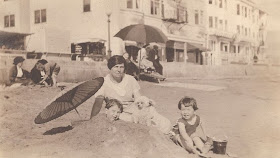Sepia Saturday challenges bloggers to
share family history through old photographs.
This week’s Sepia Saturday prompt is every family
historian’s dream: the family
bible. That record of births and deaths
has been at the core of many a fight when dividing the family treasures. My sister and I didn’t have that worry
because there was no family bible to fight over.
We eyed a different object of desire – an autograph book.
 |
Autograph book belonging to Mary Eleanor Davis Slade
entries dated 1940-1941 |
One day while Momma was undergoing chemo treatments, my
sister and I sprawled out across the bed with her and pulled out the autograph
book. Unlike most things that were
packed away, the autograph book was always nearby in a valet on the dresser. We had read it numerous times. Oh, there are no famous signatures, just silly
poems written by Momma’s friends back in 1940 and 1941 when she was about 11-12
years old. Yet we always laughed
hysterically as if reading them for the first time.
That day Momma said, “All the nice things in this house
and you’ll probably fight over who gets the autograph book.”
Hmm, wuddayaknow, look who has it.
Silly poems, bad spelling, and promises of devotion penciled on faded
pastel pages of pink, yellow, and green reflect the innocence of the pre-teen
years and the emerging interest in BOYS.
I don’t know if the autograph book stands on its own or if it’s one of
those “you had to be there” to appreciate it.
So at the risk of failing to amuse, I am sharing some of my favorite
entries.
Shenandoah
Dear Mary,
When you get married and live on a hill send me a kiss by
the whipperwhill. [sic]
Anne Staples
[a friend who lived one street away]
May 29, 1941
When you get married and move down South remember me and
my big mouth
When you get married and married [sic] and have
twins. Don’t come to me for safty [sic]
pins.
Three little words
Forget me not
Your Frined [sic]
Iris Budd
[a neighborhood friend in Cradock]
Dec. 25, 1940
Shenandoah VA
Dear Mary,
Do as your mother bids you, and do it with grace. And when the boys try to kiss you slap them
in the face.
Yours till the Mississippi River runs dry.
Margaret Jennings
[a friend who lived next door]
Dear Mary Eleanor,
Don’t kiss a boy with the eyes of blue
He’ll kiss you once and ask for 2
Don’t kiss a boy with the eyes of gray
He’ll kiss you once and turn you away
Don’t kiss a boy with the eyes of black
He’ll kiss you once and turn his back
Don’t kiss a boy with the eyes of brown
He’ll kiss you once and turn you down
Your truley [sic]
Marjorie Sue Runyon
[a school friend in Portsmouth]
Dear Mary Eleanor
Your heart is not a play thing
Your heart is not a toy
But if you want it broken,
Just give it to a boy.
Yours until the Statue of Liberty trucks down Broadway
Love, Mary Jane
PS Forget me not
[Mary Jane Via, a friend from school in Portsmouth]
Dear Mary,
I love you, I love you
I love you so well
If I had a peanut
I’d give you the shell.
Yours until the ocean wears pants to keep its bottom dry.
Love, Mary Lee Hodges
[I think this is actually Grandma’s friend]
First comes love, then comes marriage,
Then comes Mary Eleanor with a baby carriage.
If [name has been erased] lived across the sea
What a good swimmer Mary Eleanor would be.
When you get married and move to France
Save me a piece of lace off your wedding pants.
 Down in the valley stands a big, big rock
Down in the valley stands a big, big rock
With 3 little words forget me not.
A box of candy, a couple of kisses
Will change your name from Miss to Mrs.
You may fall from tops of buildings
You may fall from far above
But when you fall the hardest
Is when you fall in love.
Love, Joanne
[a life-long friend Joanne Palmer Stainback]
I saved the best for last:
I know you like Pearce
But who could help it,
With his eyes that are so fearce [sic];
His black wavy hair
Makes your heart jump in the air.
You have all the boys on a string
But when you get ready to sing
 Well, we won’t say what happens.
Well, we won’t say what happens.
There was a boy named Billy
But he was so silly.
With those blue eyes of yours
You knock the boys out of doors.
Then there’s David
 When he looks at you with his brown eyes
When he looks at you with his brown eyes
You go to him and confess your lies.
This is all s - - -
But who gives a d - - -
I DON’T!
Love (Mike)
(Worm)
Yours till this all comes true.
Even as I write this, I’m laughing about “Pearce … with
eyes that are so fearce.” What
imagery! What spelling! But at least it’s original.
Now I've been inspired to leave you with my own original poem:
When you get married and start a blog,
Don’t ask me to walk your dog.

©
2014, Wendy Mathias. All rights reserved.
































